Box Tree Moth
ID
ENTO-445NP
Pest Alert
The box tree moth, Cydalima perspectalis (Lepidoptera: Crambidae), is not known to be present in Virginia, but it has the potential to establish and pose a serious risk to our ornamental and landscape boxwood plantings if introduced. It was detected in Toronto, Canada, in 2018.
Description
Adult: The adult moth has a wing span of approximately 40-45 mm or about 1-¾ inch. The wings are white with bronzy-brown margins (Fig. 1). There is also a variant with mostly brown wings except for two small white spots.
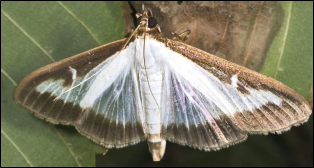
Larva: The larva has a black head capsule and a pale green body with a row of black dots on its back and white and black stripes on its side (Fig. 2). These stripes may be broken with gaps on some individuals. Loose silk webbing can be found where the caterpillars are feeding.
Box tree moth eggs are laid on the underside of leaves (Fig. 3). After hatching, the larvae grow, molt, and reach the pupal stage in as little as 14 days. The pupal stage lasts about two weeks and adults live about two weeks as well. Box tree moth overwinters in the larval stage in a silken cocoon spun between two leaves.
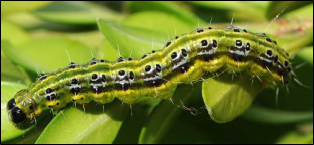
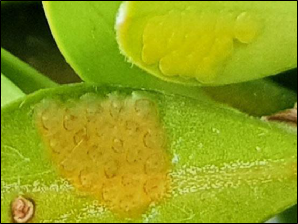
Damage
The caterpillar of the box moth damages boxwood by consuming the leaves from the edges, making notches into the leaf tissue, or by skeletonizing the leaves so that they turn brown (Fig. 4). In extreme cases the shrub will be entirely defoliated (Fig. 5).
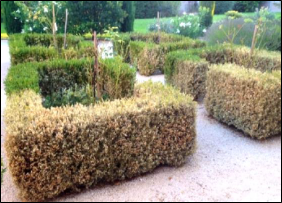
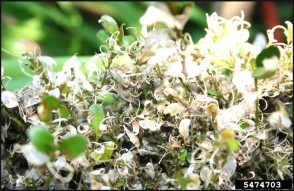
Box Tree Moth Origin
The box tree moth is native to Asia and has been reported from China, India, Iran, Japan, and South Korea. It was found in Germany and the Netherlands in 2006, likely arriving in a shipment of Buxus plants from Asia. It is now found in 30 European countries.
The box tree moth was detected in August 2018 in urban Toronto, Canada, by a citizen scientist who reported it via iNaturalist. The current distribution includes much of urban Toronto.
Pest Potential for Virginia
The box tree moth feeds on species of boxwood (Buxus spp.) that are grown commercially in Virginia nurseries and are commonly used in Virginia landscaping.
In Asia it is considered a minor pest, but it is a serious problem where it has been introduced in Europe. Box tree moth feeds on leaves and can cause complete defoliation of boxwoods. In Europe and Asia the box tree moth has been recorded from Buxus balearica, Buxus bodinieri, Buxus harlandii, Buxus microphylla (little-leaf box), and Buxus sempervirens. It is considered a serious defoliator of woodland Buxus sempervirens, a native boxwood in Europe.
Biology
The box tree moth has 1-5 generations per year depending on its geographic location. The potential number of generations per year it could have in Virginia is unknown, but box tree moth has three generations a year in southern Europe, which has a climate similar to Virginia. It can survive to -22º F and thus would be able to overwinter in all parts of Virginia.
Find your local extension office here.
Virginia Cooperative Extension materials are available for public use, reprint, or citation without further permission, provided the use includes credit to the author and to Virginia Cooperative Extension, Virginia Tech, and Virginia State University.
Virginia Cooperative Extension is a partnership of Virginia Tech, Virginia State University, the U.S. Department of Agriculture (USDA), and local governments, and is an equal opportunity employer. For the full non-discrimination statement, please visit ext.vt.edu/accessibility.
Publication Date
March 10, 2021



